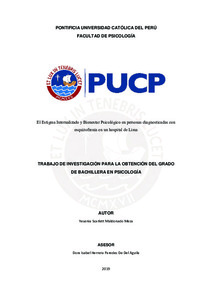| dc.contributor.advisor | Herrera Paredes De Del Aguila, Dora Isabel | |
| dc.contributor.author | Maldonado Meza, Yesenia Scarlett | |
| dc.date.accessioned | 2020-12-01T21:31:20Z | |
| dc.date.available | 2020-12-01T21:31:20Z | |
| dc.date.created | 2019 | |
| dc.date.issued | 2020-12-01 | |
| dc.identifier.uri | http://hdl.handle.net/20.500.12404/17603 | |
| dc.description.abstract | La presente investigación tiene como objetivo describir la relación entre el estigma
internalizado y las dimensiones del bienestar psicológico (autoconcepto, autonomía,
relaciones positivas, sentido de la vida, dominio de la vida, crecimiento personal) en
pacientes diagnosticados con esquizofrenia en un hospital psiquiátrico de Lima. La
muestra estuvo constituida por 47 personas, 64% hombres y 36% mujeres, cuyas edades
oscilaron entre 18 y 65 años (M= 34,55; DE= 11.56). Se utilizó dos instrumentos de
medición que fueron los siguientes: Estigma Internalizado de Enfermedades Mentales
(Bengochea-Seco, 2016) y Bienestar Psicológico (Díaz, 2006) las características
psicométricas de los instrumentos fueron analizadas y se tomaron decisiones específicas
para procesar el análisis de datos. Los hallazgos mostraron que las variables de estudio
no se relacionaron en el sentido esperado. Sin embargo, se recomienda seguir
investigando los constructos planteados desde un enfoque cualitativo. | es_ES |
| dc.description.abstract | This research aims to describe the relationship between internalized stigma and the
dimensions of psychological well-being (self-concept, autonomy, positive relationships,
meaning of life, domain of life, personal growth) in patients diagnosed with schizophrenia
in a psychiatric hospital of Lima. The sample consisted of 47 people, 64% men and 36%
women, whose ages ranged from 18 to 65 years (M = 34.55; SD = 11.56). Two measuring
instruments were used that were the following: Internalized Stigma of Mental Illnesses
(Bengochea-Seco, 2016) and Psychological Well-being (Díaz, 2006) the psychometric
characteristics of the instruments were analyzed and decisions were made to process the
data analysis. The findings showed that the study variables were not related in the sense
expected. However, it is recommended to continue investigating the constructs proposed
from a qualitative approach.. | es_ES |
| dc.language.iso | spa | es_ES |
| dc.publisher | Pontificia Universidad Católica del Perú | es_ES |
| dc.rights | info:eu-repo/semantics/openAccess | es_ES |
| dc.rights.uri | http://creativecommons.org/licenses/by-nc-sa/2.5/pe/ | * |
| dc.subject | Estigma | es_ES |
| dc.subject | Bienestar | es_ES |
| dc.subject | Esquizofrenia | es_ES |
| dc.title | El Estigma Internalizado y Bienestar Psicológico en personas diagnosticadas con esquizofrenia en un hospital de Lima | es_ES |
| dc.type | info:eu-repo/semantics/bachelorThesis | es_ES |
| thesis.degree.name | Bachiller en Psicología | es_ES |
| thesis.degree.level | Bachillerato | es_ES |
| thesis.degree.grantor | Pontificia Universidad Católica del Perú. Facultad de Psicología | es_ES |
| thesis.degree.discipline | Psicología | es_ES |
| renati.advisor.dni | 07926509 | |
| renati.advisor.orcid | https://orcid.org/0000-0002-8327-9435 | es_ES |
| renati.author.dni | 71246623 | |
| renati.discipline | 313016 | es_ES |
| renati.level | https://purl.org/pe-repo/renati/level#bachiller | es_ES |
| renati.type | https://purl.org/pe-repo/renati/type#trabajoDeInvestigacion | es_ES |
| dc.publisher.country | PE | es_ES |
| dc.subject.ocde | http://purl.org/pe-repo/ocde/ford#5.01.00 | es_ES |






